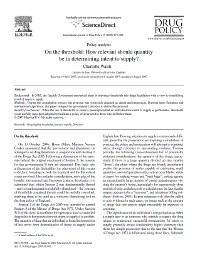The impact of heroin prescription on heroin markets in Switzerland
A program of heroin prescription was introduced in Switzerland in 1994. This initially targeted 1,000 heavily dependent heroin users, most of whom were also involved in drug dealing and other forms of crime. It has recently been extended to cover 3,000 users. Evaluation of its impact on users shows large reductions in use of illicit drugs and in drug-related crime.

Autores
The evaluations were not designed to assess the program's impact on drug markets, but some data can shed light on this. It seems likely that users who were admitted to the program accounted for a substantial proportion of consumption of illicit heroin, and that removing them from the illicit market has damaged the market's viability. Before involvement in the program, a large proportion of users sold drugs to finance their own use, since the illicit drug market in Switzerland relies heavily on users for retail drug selling.
It is likely, therefore, that the program additionally disrupted the function of the market by removing retail workers. The workers no longer sold drugs to existing users, and equally important, no longer recruited new users into the market. The heroin prescription market may thus have had a significant impact on heroin markets in Switzerland.
Heroin substitution targeted hard-core problematic users (heavy consumers), assuming that 3,000 addicts represent 10% to 15% of Switzerland's heroin users that may account for 30% to 60% of the demand for heroin on illegal markets. Heavily engaged in both drug dealing and other forms of crime. They also served as a link between wholesalers and users. As these hard-core users found a steady, legal means for their addiction, their illicit drug use was reduced as well as their need to deal in heroin and engage in other criminal activities.
The heroin substitution programme had three effects on the drug market:
- It substantially reduced the consumption among the heaviest users, and this reduction in demand affected the viability of the market.
- It reduced levels of other criminal activity associated with the market.
- By removing local addicts and dealers, Swiss casual users found it difficult to make contact with sellers.
Volume 11, pp. 83-99
Crime Prevention Studies,
2000